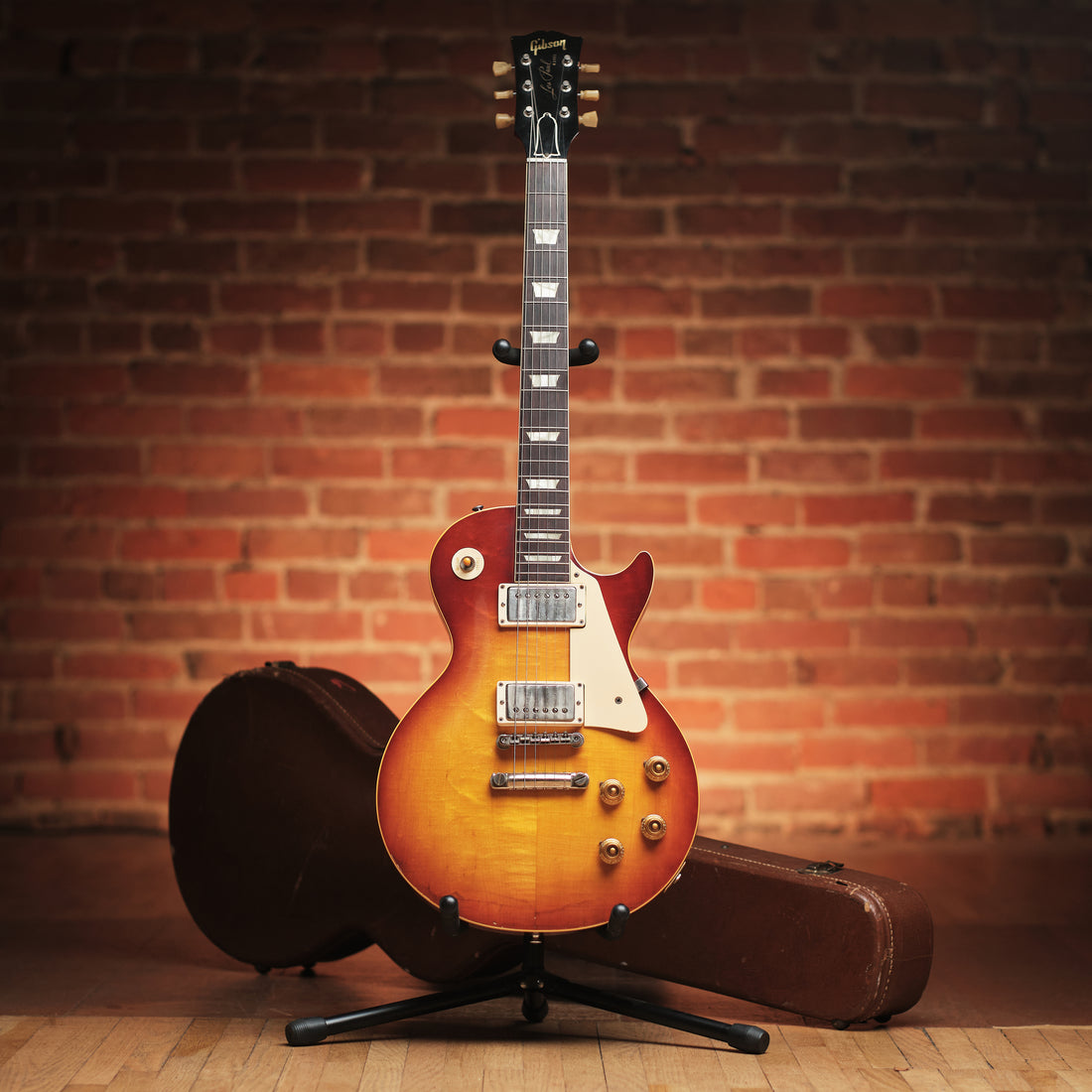1958 Fender Stratocaster

Researching the story of a truly amazing vintage Fender always makes me feel a little like a lactose intolerant guy cutting into a tremendous lasagna. Uncovering its irresistible anatomy layer by layer, component by component, all the while knowing that it can never be mine. The cost is simply too great. But even by my slightly jaded standards this is a special one, so lets get to dissecting this Strat one piece at a time.
The first layer of cool: this is a very original 1958 maple board Strat. The switch. nut, and frets have been replaced with modern equivalents, but all the original components are included with the instrument and could be reinstalled if need be. Second layer: this guitar is a factory black instrument. Custom colors produced prior to Fender’s introduction of the first custom color chart in 1960 are exceedingly rare. Some even argue that these are the only true “custom colors,“ as they were picked individually by the customer from DuPont’s massive library of colors. This Strat went back to the factory in the early 60s for a body-only refinish, but the original color was also black. How do we know this? That brings us to the third and most unbelievable level of cool: we have an original photo of the first owner playing this Strat along with his band in the late 50s. His band was called “The Silver Tones” and although they were young, these guys had an eye for great gear. In addition to the custom color Strat, the rhythm section consisted of a mint-condition gold guard Precision Bass and a tasteful Slingerland jazz kit. Where these instruments are today I have no clue, but the Fender is still the most intriguing by far. 50s Strats with this kind of provenance don’t come up for sale often, and custom color examples are bordering on unheard-of. The early factory refin keeps this Fender well south of the six-figure mark, but is still one of the most interesting examples we’ve come across.
1962 Fender Stratocaster

I’m sure faithful readers of our newsletter are sick of hearing this, but I’ll say it one more time: not all vintage refins are created equal. There was a time when they were painted with a broad brush (figuratively as well as literally) and were priced across the board at roughly half the cost of their original equivalents. Those days are long over, though, and variances in quality and age of a refinish can easily make a five-figure difference in the final sale price. So where does this particular Strat fall on that spectrum? Pretty darn high.
As far as we know, we are the first shop in at least several decades to represent this guitar as a refinished instrument. Most recently, it was sold to the late Paul Allen erroneously as a factory foam green Strat and stayed in his personal collection for many years. What he paid for it we have no idea, but the going rate for an original example today would be at least a few times more expensive than this one. Finish aside, this is a shockingly righteous pre-CBS Strat. A new nut and frets are the beginning and end of its list of additional modifications, both of which are almost assumed for a guitar of its age. Paul was very well known in Seattle for throwing frequent and lavish parties that would often evolve into impromptu jam sessions with his guests; Ringo Starr, Joe Walsh, and Mick Jagger were a few regulars. Even if Mr. Allen wasn’t one of your musical idols, it’s almost certain that this guitar found its way into the hands of at least a few guitar gods over the years. An excellent guitar with a tremendous history, it’s hard to ask for more than that.
1959 Gibson Les Paul Standard

What is there to say about Bursts that hasn’t already been said? 1959 is the banner year for the model without question, and it doesn’t take long with this guitar in hand to tell why. The oft-copied ’59 neck profile is clear and present. The slightly faded sunburst is exactly what the replicas strive for. The original PAF humbuckers are everything you’d hope they would be. This example is a true tour de force of what makes these Les Pauls so revered and sought after.
The longtime collectability of these guitars mean that they often come with a story, and the history of this particular instrument is a shining illustration of that. It was original found by legendary guitar tech and Burst authority Mike Hickey. Neal Schon, famously the guitarist for Journey, let it be known that he was interested in acquiring a ’59 Standard, and this is the instrument that was procured for him. After years of faithful service, it was once again made available for purchase. This is another 100% original Burst, and much like our ’58 boasts an incredibly light weight for the era. The tone, playability, and tastefully subtle flame of the top are everything a Burst should be. This particular guitar has also already been sold to its next owner, but our selection of golden-era Les Pauls is continually evolving and is updated daily. A Youtube video showcasing this guitar was also made public on our channel, for those interested in examining further this amazing piece of history.
1969 Gibson Dove

It’s difficult to imagine an instrument undergoing a more drastic evolution over the span of a decade than the guitar did in the 1960s. In the early 60s the guitar played a somewhat peripheral role in American culture. You may have watched Conway Twitty strumming his OM-18 on American Bandstand, but it was far from the star of the show. By the end of the decade and due largely to the Beatles, there was a guitar in nearly every household and Jimi Hendrix was shredding the National Anthem for an unwashed sea of conscientious objectors. The two major American guitar companies had been sold off to multinational conglomerates and still couldn’t meet the seemingly insatiable demand for their instruments. Things would never be quite the same.
1969 was the perfect time to play a guitar with a dove on it. It was common knowledge at the time that carrying a flat-top acoustic along with a copy of The Bell Jar would secure you at least a date with any girl on NYU’s campus, regardless of proficiency with either. This particular example remains in extremely minty condition with no discernible repairs, virtually unheard of for a guitar of its age. At some point the original owner decided amplification was needed, presumably so his neighbors could hear his “pretty decent” solo cover of Fortunate Son. His solution was to install a DeArmond soundhole pickup, which may not reproduce the sound of an acoustic guitar as faithfully as modern pickups, but without a doubt sounds exactly like a DeArmond soundhole pickup. This instrument is a true time capsule from a bygone era defined by its incredibly formative popular music and questionable hygiene. Whether you like it or not, there isn’t a cleaner 60s Dove out there at any price.
1958 Gibson Les Paul

What is there to say about Bursts that hasn’t already been said? The Les Paul Standard from 1958-60 represents the quintessential rock and roll guitar, and is arguably the most recognizable guitar design ever made. Everyone you ask has a different opinion on their meteoric rise in price as of late, but the fact remains: folks can’t stop buying them, reissuing them, and talking endlessly about them. This particular example is one that lives up to the hype.
1959 might be the year most coveted by the masses, but the fact is that the 1958 Burst is by far the rarest of the bunch. It is often glossed over that the vast majority of ‘58s were PAF-equipped Goldtops, with the sunburst finish making its debut in the fall of that year. Only a few months of manufacture mean that production numbers were extremely low and original examples are few and far between, even compared to the elusive 59s and 60s. This ’58 is 100% original, right down to the frets, nut, and even the screws. It tips the scales at an impressive 8lbs 7oz, an extremely lightweight Burst by any standards. No breaks, repairs, finish work, or modifications. With an already limited number of 58s out there, a completely unmolested instrument will only become rarer and more desirable. This Burst has already been sold, but check out our Youtube channel for a comprehensive demo video.


